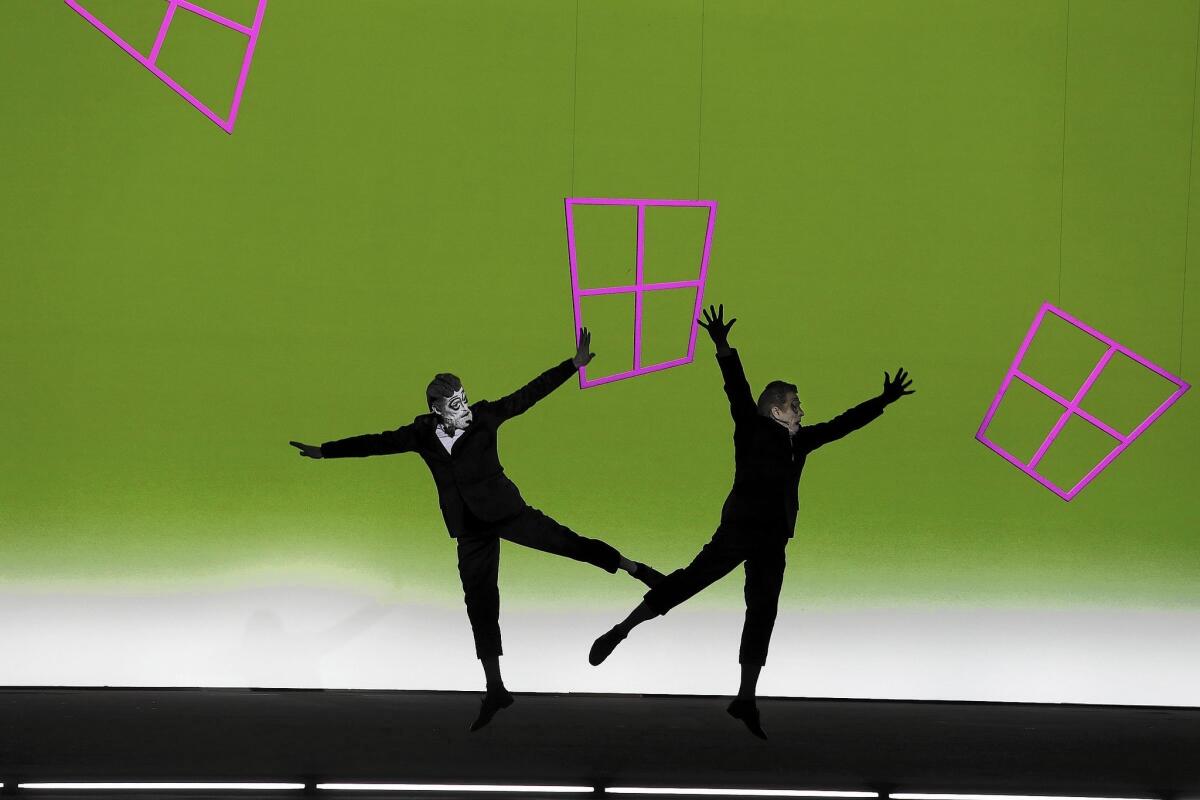Review: Baryshnikov sings, Dafoe dances in avant-garde ‘Old Woman’

The old woman’s corpse rots. Suddenly, it becomes unclear whether seven comes before or after eight, when counting to 10.
But Baryshnikov sings! Dafoe dances! They’re happy as a couple of bees.
“The Old Woman,” a delirious two-man sideshow for Mikhail Baryshnikov and Willem Dafoe that’s based on an early 20th century Russian avant-garde novella by Daniil Kharms and directed and designed by Robert Wilson, made a quirky, quick visit to Royce Hall at UCLA on Friday night, the first of two shows here.
That the stage could remain aglow with nonstop wonder for nearly two hours has been a Wilson trademark for the last half century. That humor could inhabit the darkest shades of black yet remain carefully carefree remains a customary Wilson revelation. That you needn’t know what to think, and in not knowing might become freed from linear analysis, is an ongoing Wilson gift.
Wilson and Kharms, Baryshnikov and Dafoe, Darryl Pinckney (who adapted — radically — Kharms’ text) and Hal Willner (who came up with an off-the-wall musical playlist) are matches made in absurdist theater heaven. But the greatest match of all is Wilson and Baryshnikov, the first meeting of today’s two great masters of stage presence and deliberate movement.
In Kharms’ novella, a writer who expresses a particular disgust when it comes to children or dead people encounters a woman holding a clock with no hands. Later, she shows up at his door, enters, bosses him around, sits in his favorite chair and drops dead. Annoyed, he kicks her in the head, the most appropriate way to treat a corpse, leaving a nasty bruise. It will now appear that he has killed her, and he has to figure out what to do with the body.
A series of slapstick encounters follows that includes another ne’er-do-well writer, a flirtatious young woman and an ill-fated attempt to stuff the old woman in a trunk and dump her body in a swamp. Kharms’ world is full of innocent-seeming traps.
Kharms’ protagonist’s self-proclaimed expression of his genius will be his story, in which a miracle worker works no miracles and dies derelict. This is where Wilson steps in. He works miracles onstage that have no meaning. They are miracles out of context, but miracles nonetheless.
Wilson’s approach to “The Old Woman” is not new for him. It resembles the entr’actes he called knee plays in his first great international success, the 1976 opera “Einstein on the Beach,” which he created with composer Philip Glass. In these knee plays, a dancer and an actor were like twins in their stylized movements and repetitive, wistfully ruminative near-nonsense.
Baryshnikov and Dafoe take this much further. With clown whiteface and corkscrew hair, they are many kinds of twins. Neither is consistently one character or another. They are a slapstick pair. They do the two-step. They move with Wilsonian slowness, make sudden changes of expression. A scream, in Wilson World, comes out of nowhere and might be silent or deafening, instantaneous or seem to go on jaw-exhaustingly forever.
Each of Pinckney’s 12 scenes uses the relationship differently, from instances of solo brooding (Baryshnikov in both Russian and English) to a joint song-and-dance act. Baryshnikov’s extraordinary grace is the center and greatest inspiration of the show. But Dafoe brings grit and intensity and a sense of danger that is also a necessary corrective. He also dances with surprisingly impressive aplomb, and Baryshnikov reveals a surprisingly lyrical baritone singing voice.
The production had its premiere in Manchester, England, last year and is winding up a world tour in Berkeley this weekend. What is new is that Dafoe has grown a beard for a coming film, and although the company has been touchy about that (forbidding closeup photography, for instance), the beard adds a distinctive visual touch.
Expectedly, the sets enchant, with Wilson’s radiant use of light and his elegant yet unsettling stage properties — a cute bird, a not cute bird, distorted and expressionist chairs, a surreal clock with a gloved hand for a hand, a biplane — each a beautiful, perfectly made object you would love to take home.
Willner’s recorded soundtrack adds another dimension. The range is just about everything you could think of and much you would never think of. Scratchy old operatic 78s merge with show tunes, the blues. There is also the seductive use of Arvo Pärt. Wilson has just begun working on a new project with the Minimalist Estonian composer in Tallinn. He has also lately directed a television project with Lady Gaga and Tony Bennett.
“The Old Woman” is, in the large scheme of the ever-escalating Wilson World, a road-show roundelay, theater as hit and run. It comes into town and is gone before you know it, leaving you not quite believing your eyes or your senses.
We have the Center for the Art of Performance at UCLA, which has made Wilson a fellow, to thank for it. Now we need more work here from a director who has major productions of Genet’s “The Blacks,” Shakespeare’s Sonnets and a long list of opera productions happening somewhere (which is to say Europe).
More to Read
The biggest entertainment stories
Get our big stories about Hollywood, film, television, music, arts, culture and more right in your inbox as soon as they publish.
You may occasionally receive promotional content from the Los Angeles Times.







